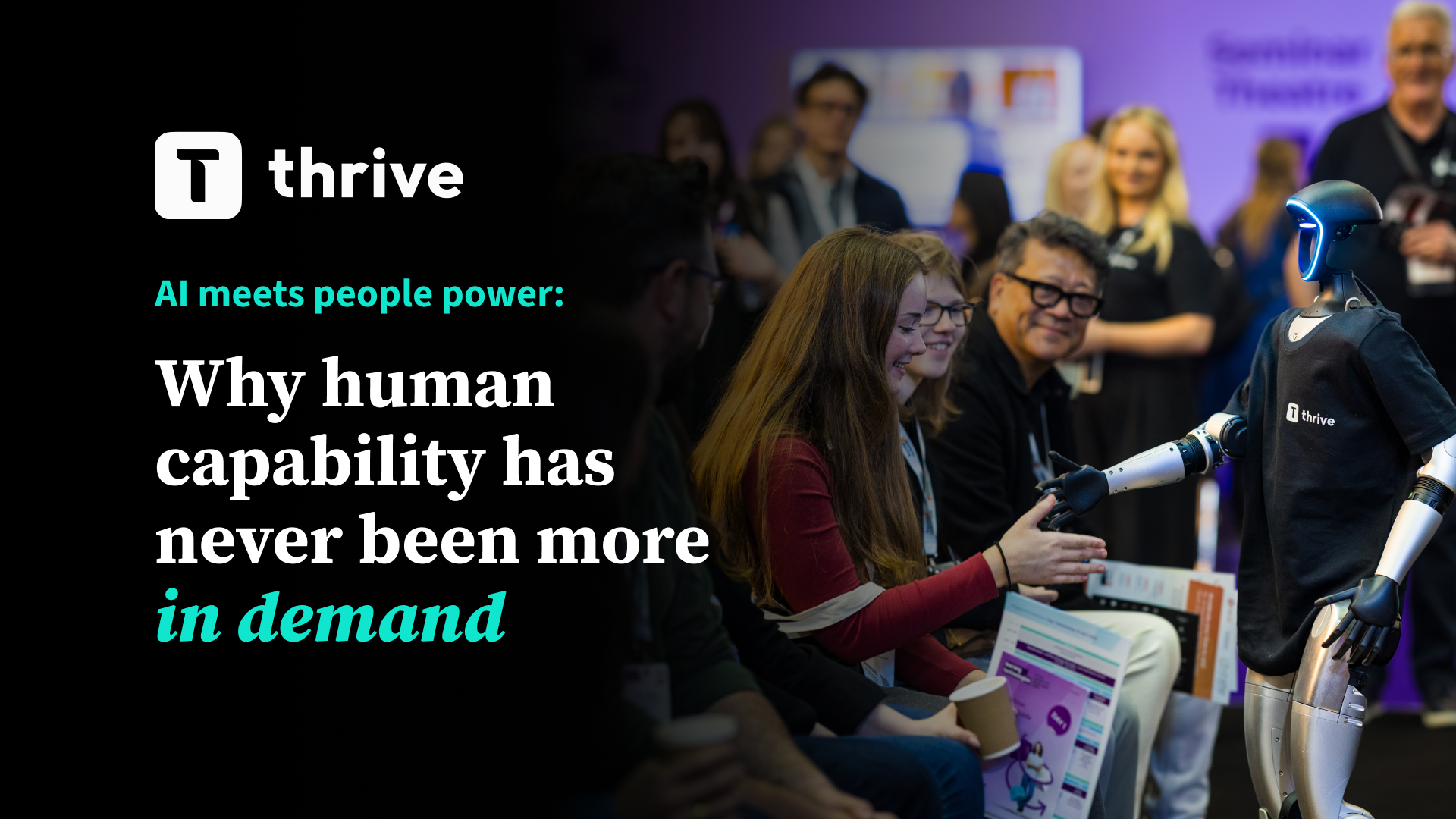
AI Meets People Power: Why Human Capability has Never been More in Demand
Is AI really replacing people? Far from it. As machines take on more tasks, the demand for human skills — judgment, creativity, emotional intelligence — is skyrocketing. In this month's Summit Solutions, Thrive reveals why investing in people power is the real competitive edge in an AI-driven world.
The rise of AI and the case for human capability
In the fast-moving age of AI, you’d be forgiven for assuming that humans will eventually be edged out of the picture. After all, machines seem to be capable of everything from generating text, to automating workflows, to administering therapy.
But while the capabilities of AI are rapidly increasing – and some humans are arguably becoming more dependent on it – human capability is rising to meet it.
Far from replacing people, AI is creating a world in which human skills like judgement and creative thinking are more important than ever before. AI might be able to generate a picture of photo-realistic humans, or create a convincing video, but it can’t relate to human beings like we ourselves can.
Technology can enable, but people create real value. Let’s discuss why human capability is more important than ever before.
AI is reshaping, not removing, human roles
As with every major technological shift, AI is streamlining repetitive tasks and accelerating productivity.
The critical difference today is scale and speed. Machine learning systems can now produce reports, marketing copy, and even lesson plans in seconds.
But these systems lack the important context that defines effective decision-making. Organisational culture, stakeholder dynamics, and ethical implications aren’t captured in data sets; they’re interpreted and acted upon by people.
AI can provide options, but it can’t navigate complexity or lead meaningful change.
The implication is clear: as AI takes on operational tasks, the strategic value of human insight only grows.
The widening skills gap
The acceleration of AI adoption is also exposing a significant skills gap.
McKinsey & Company research forecasts that by 2030 demand will increase sharply for “technological, social and emotional, and higher cognitive skills.”
Organisations that fail to invest in these areas risk being left behind.
Traditional training approaches (which often focus narrowly on compliance or immediate technical needs) are no longer sufficient. What is required is capability building: equipping employees with resilience, adaptability and the capacity to learn in a rapidly changing environment.
L&D functions now have a strategic mandate to close this gap, and position their organisations for long-term success.
From content to capability
Historically, learning and development has emphasised content delivery through courses, videos and assessments.
But with AI now able to generate such content at scale, this approach is no longer distinctive.
The question has shifted from “what should employees know?” to “what should employees be able to do in real-world contexts?”
This requires a focus on experience design rather than content curation, embedding learning in practice and reinforcing it through coaching and mentoring.
Here, Thrive's partnership with Guider offers a compelling solution. AI can personalise pathways and surface insights, but mentoring and coaching provide the human elements that technology can’t replicate. Together, they ensure that learning translates into capability.
L&D’s strategic role in an AI-enabled world
The impact of AI on the workforce requires L&D leaders to move beyond programme delivery, and embrace a broader organisational mandate. Their role is to build adaptive, resilient and future-ready organisations.
This involves close collaboration with business leaders to identify emerging capability needs, aligning learning strategies with organisational goals, and leveraging data not only for reporting but also for long-term workforce planning.
Crucially, it also means embedding ethical awareness and compliance into everyday learning, ensuring that the deployment of AI is responsible, transparent and accountable.
When positioned in this way, L&D becomes a driver of growth.
The paradox of AI: more technology, more humanity
The paradox of artificial intelligence is that the more powerful it becomes, the greater the demand for human strengths. Emotional intelligence, ethical judgement and collaborative problem-solving remain beyond the reach of machines — and their value is rising accordingly.
The organisations that succeed will not be those that attempt to replace people with technology, but those that create a balanced partnership in which each complements the other.
AI will not replace people, but individuals who know how to apply AI effectively and responsibly will replace those who do not.
Conclusion: investing in people power
As AI continues to redefine work, the organisations that thrive will be those that invest in human capability as a strategic priority. By integrating Guider’s mentoring and coaching into our platform, Thrive is enabling organisations to harness the benefits of AI while strengthening the uniquely human skills that drive long-term performance.
In this new era, the question is not whether organisations can afford to use AI responsibly alongside human capability. The question is whether they can afford not to.
By Alex Mullen , Thrive Learning
At Summit Events, we see these conversations play out first-hand across our summits. Thrive will be joining us at the Human Resource Summit, Human Resource & People Development Summit Dubai, and the People Development Summit—bringing their insights on how AI and human capability can work hand in hand. Our events create the space for leaders to connect, challenge thinking, and explore exactly these kinds of future-facing ideas.


